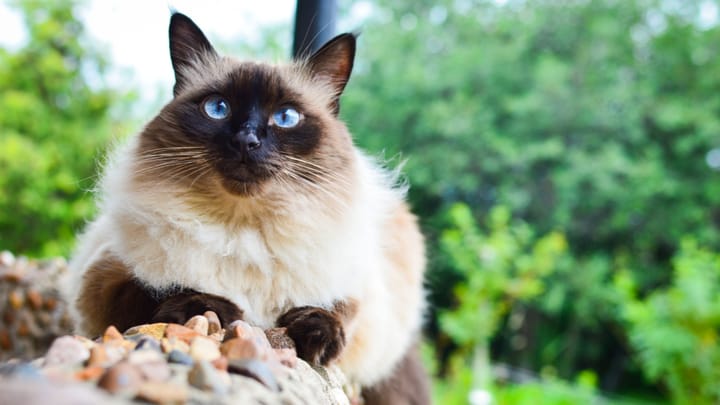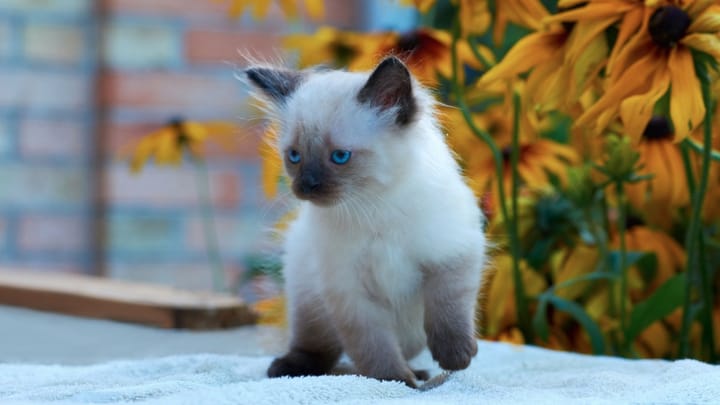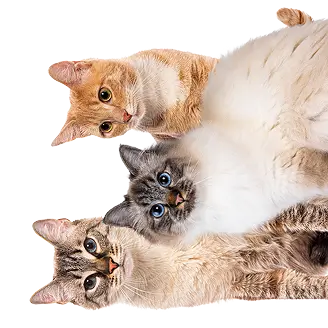Balinese cat
Other name: Long haired Siamese


Despite their name, this breed is not native to Bali. They originate from litters of Siamese kittens, where some were born with mid-length fur. At the time, they were of little value to their breeders as they did not meet the requirements for Siamese cats. It was not until 1950 that two breeders became interested in these mid-length-haired kittens, and in order to preserve this trait they decided to try and create a new breed. These cats emanated such grace that one of the breeders decided to change their name (formerly known as Long-haired Siamese) in honour of the elegance of Balinese dancers.
|
Life expectancy |
The Balinese cat has a life expectancy of between 15 and 20 years |
|
Temperament |
|
|
Adult size |
Female
Approximately 12 in
Male
Approximately 12 in
|
|
Adult weight |
Female
Between 7 and 11 lb
Male
Between 7 and 11 lb
|
|
Coat colour
Seal, chocolate, blue, lilac, cream, tortoiseshell |
Black Brown Cream Blue |
|
Type of coat
Mid-length. |
Long |
|
Eye colour
Blue. |
Blue
|
|
Purchase price |
The Balinese cat costs approximately 300£ |
Balinese reach sexual maturity early in their lives (Like Siamese): they can come into heat at 6 months old.
More details about the Balinese cat
Balinese cat: Origins and history
This breed did exist naturally, as from time to time long haired kittens were born into Siamese litters. However, they were then removed from breeding programmes, as they did not meet the required standards for Siamese cats. Two Siamese breeders in the United States began breeding Long Haired Siamese by selecting precise kittens. Since the year 2000, their popularity has declined due to the appearance of other breeds, which makes it quite rare in Europe.
Physical characteristics of the Balinese cat
Balinese have long, athletic and muscular bodies with thin frames. This gives them their majestic natural elegance. They have beautiful triangular shaped heads with almond blue eyes.
Balinese cat: Characteristics
Balinese cat: Behaviour
Breed compatibility Balinese cat
Balinese cat: Purchase price
A Balinese kitten costs approximately £300. Their price varies depending on their lineage, age and sex. They cost approximately £25 per month to keep them healthy and to feed them well!
Balinese cat: Shedding
Light
Even during moulting, Balinese only lose a little hair. This breed has no undercoat.
Balinese cat: Grooming
Weekly brushing and combing is usually sufficient for Balinese.
Balinese cat: Health
15 to 20 years.
Their thin fur and lack of an undercoat mean that they are poor at dealing with large swings in temperature.
By expending their energy daily, and providing them with a balanced diet using an interactive bowl, you will prevent your cat from becoming overweight.
Balinese can develop the same illnesses as any other cats, such as oral diseases. Some other diseases may appear, including:
Hypertrophic cardiomyopathy - this results in the thickening of the heart muscle. This pathology causes heart failure that can result in arrhythmias or even pulmonary aedema. Screening can be done by means of an echocardiography examination, which is usually renewed annually. Treatment can be administered to improve the cat’s quality of life.
Progressive retinal atrophy - a disease that can cause blindness in Balinese. Screening tests exist.
Renal amyloidosis - an irreversible hereditary disease. This disease progresses quickly and clinical signs generally arise between the age of 1 and 5. They are similar symptoms to those of severe renal failure. There is no screening test to date as the gene(s) that cause the disease have not yet been identified. Nevertheless, vigilance on the part of the breeders has caused this disease to remain rare.
Balinese have on average 4 kittens per litter.
Cross breeding is permitted with Siamese, Mandarin, Orientals and other Balinese.





